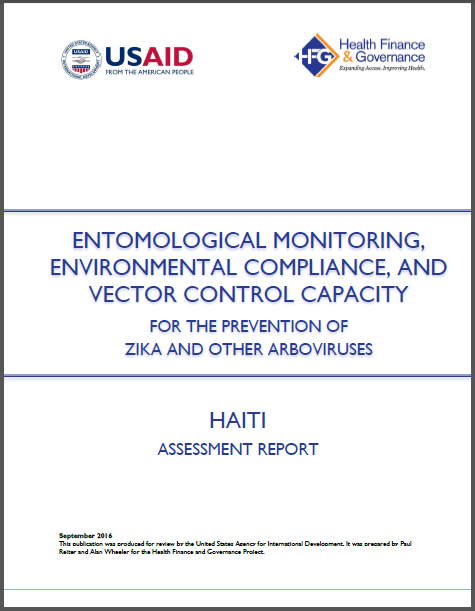Entomological Monitoring, Environmental Compliance, and Vector Control Capacity for the Prevention of Zika and Other Arboviruses: Haiti Assessment Report
Categories: Health Systems Research, Home Page Map, Publications, Vector-borne Diseases, Where We Work, Zika
Resource Type: Report
Authors: Paul Reiter and Alan Wheeler
Published: 9/1/2016
Resource Description:
 The first case of local, vector-borne transmission of the Zika virus in the Americas was identified in May 2015 in Brazil. By July 2016, the virus had spread to nearly all Zika-suitable transmission zones in the Americas, including the majority of countries and territories in the Latin America and the Caribbean region. Governments in the region face a formidable challenge to minimize Zika transmission and limit the impact of Zika on their populations.
The first case of local, vector-borne transmission of the Zika virus in the Americas was identified in May 2015 in Brazil. By July 2016, the virus had spread to nearly all Zika-suitable transmission zones in the Americas, including the majority of countries and territories in the Latin America and the Caribbean region. Governments in the region face a formidable challenge to minimize Zika transmission and limit the impact of Zika on their populations.
The United States Agency for International Development (USAID) supports efforts to strengthen the region’s Zika response through targeted technical assistance, stakeholder coordination, and implementation of key interventions. In Haiti, the USAID-funded Health Finance and Governance project assessed country capacity to conduct vector control and entomological monitoring of Aedes mosquitoes, the primary vector of the virus. The assessment was conducted from June 8 to 17, 2016, and sought to appraise current capacities, identify strengths and weaknesses in these capacities, and recommend countermeasures, i.e., specific strategies to minimize the impact of Zika virus transmission.
The assessment identified several challenges that must be confronted in order to mount an adequately robust response to the threat of Zika in Haiti:
- Currently there is no national body to coordinate, plan, and finance a widespread and sustained vector control effort to suppress Zika transmission.
- Haiti’s existing vector surveillance and control workforce is inadequately staffed with only 12 brigades of five personnel each for the entire country.
- There is no sizeable program for surveillance or control of Zika vectors in the country, nor is there a central database for reporting surveillance and vector control efforts.
- Weak infrastructure for waste management and water supply make households susceptible to mosquito breeding via shallow containers and uncovered water storage vessels. This suggests an imperative for environment-centered treatment strategies.
- Women of reproductive age and pregnant women in particular are a high-risk population. Reaching them with behavior change communication (BCC) and information, education and communication (IEC) activities is challenged by low levels of antenatal care coverage.



